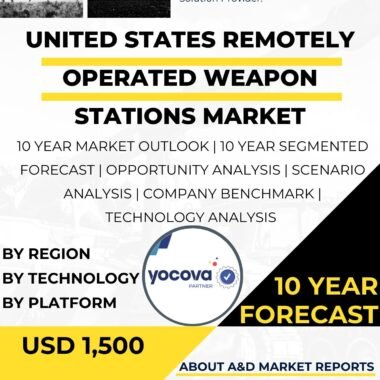Description
The Vetronics market in the United States has witnessed significant growth and technological advancements over the years, driven by the need to modernize military vehicles and improve their operational capabilities. Vetronics, a combination of “vehicle” and “electronics,” refers to the integration of advanced electronic systems and technologies into military platforms. This article provides an overview of the US Vetronics market, including its key drivers, components, applications, and major players.
The Vetronics market in the United States has seen remarkable growth over the years due to various factors. One of the key drivers is the continuous evolution and advancement of technology. The rapid progress in electronics, sensors, artificial intelligence, and communication technologies has enabled the development of sophisticated Vetronics systems. These advancements have significantly enhanced the performance and capabilities of military vehicles, making them more effective in modern warfare scenarios.
Another major driver behind the growth of the Vetronics market is the ongoing process of battlefield modernization. In response to evolving threats and challenges on the battlefield, the US military has been actively modernizing its ground vehicle fleets. Upgrading these vehicles with Vetronics solutions allows for increased automation, better situational awareness, and improved connectivity, enhancing their overall combat effectiveness.
One of the key advantages of Vetronics systems is the improved situational awareness they provide. By integrating various sensors, cameras, and radars, Vetronics systems offer vehicle crews real-time information about their surroundings. This enhanced awareness helps troops make informed decisions and respond promptly to changing battlefield conditions, ultimately improving mission success rates.
Moreover, Vetronics systems contribute to the safety and survivability of military vehicle crews. By incorporating features such as blast mitigation, threat detection, and autonomous operation, Vetronics solutions reduce the risk to personnel in hazardous environments. This aspect is particularly crucial in modern asymmetric warfare, where adversaries often employ unconventional tactics.
The applications of Vetronics in the US military are diverse and cover various types of ground vehicles. Main battle tanks, infantry fighting vehicles, armored personnel carriers, and reconnaissance vehicles are just some examples of platforms benefiting from Vetronics integration. Each of these platforms has unique operational requirements, and Vetronics systems can be tailored to suit their specific needs.
For example, main battle tanks are equipped with advanced Vetronics systems to enhance target acquisition, fire control, and navigation capabilities. These systems allow tank crews to engage targets more accurately and efficiently, giving them a tactical advantage on the battlefield.
Similarly, infantry fighting vehicles rely on Vetronics solutions for troop communication, coordination, and situational awareness. By integrating individual soldier systems with the vehicle’s Vetronics network, infantry units can operate more cohesively and respond rapidly to changing combat situations.
Armored personnel carriers use Vetronics to improve troop safety, mobility, and mission flexibility. By providing reliable navigation and terrain analysis, Vetronics systems allow carriers to traverse challenging environments more effectively while safeguarding the well-being of the troops they transport.
Reconnaissance vehicles benefit from Vetronics integration by gaining advanced surveillance and intelligence gathering capabilities. Vetronics systems on these vehicles enable real-time data transmission, supporting timely and accurate decision-making during reconnaissance missions.
Several companies in the United States are key players in the Vetronics market, contributing to its growth and innovation. These companies specialize in the development, manufacturing, and integration of advanced Vetronics solutions for military vehicles.
Northrop Grumman is one of the prominent players in the US Vetronics market. The company has developed a wide range of advanced systems, including Fire Scout unmanned helicopters for reconnaissance and surveillance missions, and the C4ISR system that provides enhanced command, control, communications, computers, intelligence, surveillance, and reconnaissance capabilities for military vehicles.
Another major player in the Vetronics market is BAE Systems, which offers a comprehensive suite of Vetronics solutions tailored for various military vehicle platforms. The company’s advanced fire control systems, situational awareness modules, and vehicle health monitoring systems contribute significantly to the capabilities of US ground forces.
General Dynamics is also a significant player in the US Vetronics market. The company provides advanced communication systems, fire control solutions, and integrated Vetronics packages for various ground vehicle platforms. These systems enable military personnel to execute missions with enhanced efficiency and safety.
Raytheon Technologies is known for its cutting-edge sensor and communication technologies, which are vital components of Vetronics systems. The company’s contribution to the Vetronics market includes advanced radar systems, electro-optical sensors, and secure communication networks that enhance the operational capabilities of military vehicles.
The Vetronics market in the United States continues to expand and evolve, driven by the increasing demands of modern warfare and the constant advancements in technology. As military operations become more complex, Vetronics systems play an increasingly critical role in providing troops with the tools and capabilities they need to succeed on the battlefield. By integrating advanced electronics, sensors, communication networks, and computing capabilities into military vehicles, Vetronics systems enhance the overall performance and versatility of these platforms, giving the US military a significant advantage in modern warfare scenarios. The development and deployment of Vetronics solutions will undoubtedly continue to be a priority for the US defense industry as it strives to maintain its technological edge and support the needs of the nation’s armed forces.




